Genre: Platformer Developer: Virtual Studios Publisher: Infogrames Players: 1 Released: 1995
Before the horrible age of digital rendered “cartoons” we presently experience, kids grew up with animated cartoons which were actually drawn. Most of those cartoons have aged terribly – graphically as well content-wise. Take the Smurfs for example – highly popular in my youth all over the world, but nowadays this kind of animation seems highly obsolete, and the same goes for the moral learning attitudes of the series. Regardless, in the 16-bit era of gaming, almost every popular cartoon or series needed to be made into a game to make as much money from the franchise as possible.
So, it’s no surprise we’ve seen a game based on the cartoon of the Smurfs as well. Released by the French Infrogrames, the game was clearly aimed at a European market. It’s possible to play in French, German, Spanish, Italian or English. The story isn’t particular interesting: the recurring villain from the cartoon, Gargamel, has just perfected a terrible plot to kidnap all the Smurfs, and four of them have disappeared already. The player assumes the roles of diverse Smurfs in different levels, each of which has different abilities. The game starts with a “stock” Smurf that can only jump. To eliminate enemies he has to jump on them in typical hop-‘n-bop fashion; however, later on the player take the role of Jokey Smurf (whose skill is throwing exploding packages), Greedy Smurf (who can throw cakes) and Brainy Smurf (who can make light in the dark) as well.
There are some bonuses available throughout the game, though not in great variety. Some of them have been hidden in little mushrooms, others are just scattered around. Raspberries upgrade your life, and Smurf dolls give you an extra life. If you collect twenty-five sarsaparilla leaves (I never knew that was the Smurfs’ favorite food), you get an additional life as well. Furthermore, you can also select twenty-five stars to access one of the two bonus games. In one of them you’re on a raft and in the other your Smurf sits on a White Stork. In both the player is able to collect more bonuses.
One would expect a game about Smurfs to be easily accessible to kids but forget about entertaining your little brother or sister with this one. Though the game has three difficult settings, it’s still pretty hard. The gameplay really is a trial-and-error experience, from the very first level. Furthermore, it’s not very often clear what does any damage, and in some of the backdrops it’s unclear if certain enemies/platforms belong to the foreground or not. The trial-and-error rule also goes for other levels, in which the player has to jump out to nowhere and hope for a platform below, ride a duck with no clue what will be next and so on. Most frustrating is that all too often it’s too hard to spot an enemy in time. Once you lose a life, it’s back to the start from the level. Just like the cartoon itself, this kind of gameplay has really aged badly. Even back then, it took quite a bit of frustration to complete this game. Luckily there is a password system, in which you see pictures of four Smurfs in different order. Not very handy to write down, but it works fine.
The control is decent, though sometimes your Smurf (no jokes here) feels kind of loose which can make it easy to jump just beside enemies/platforms/jumping feathers and so on, rather than on them. However, graphically this game deserves a compliment. The Smurfs are all large and colorful, and the same can be said of the backgrounds. Some levels are particular intriguing in terms of graphics, like the one in which the player has to navigate his Smurf on a snowboard sliding down from the back of a mountain. It looks very impressive and of Mickey Mania effect quality. The sound isn’t up to level of the graphics, but not really annoying either. It’s just forgettable backdrop music.
Besides the difficulty level of the Smurfs, another thing is bothering me, is the actual physical dimensions of the heroes. Smurfs are supposed to be small, like gnomes. Then why the hell do they encounter even SMALLER animals like hedgehogs, birds, butterflies, and other animal creatures? Also, your Smurfs – well-known nature lovers – shouldn’t touch them because that will hurt. How is that possible? Since when were animals enemies of the Smurfs? Did the creators of the game even watch the cartoon, or was there another villainous plan of Gargamel which has shrunk the animals and made them foes as well? Nothing of that caliber is told in the game.
Overall, the Smurfs is your run-of-the-mill platformer, of which we saw tons during the console battle between Sega Genesis and Super Nintendo. It’s not really bad, but not particular memorable either. It looks great, but the combination of a childish game with a high difficulty factor wasn’t really such a brilliant idea after all.
SCORE: 6 out of 10

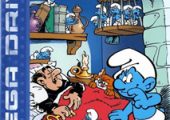
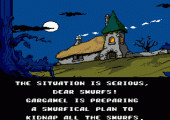
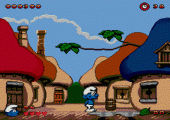
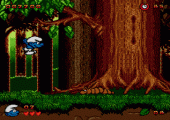
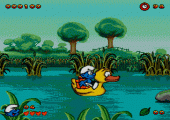
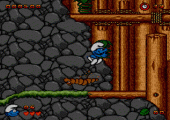
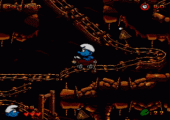
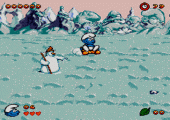
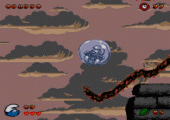
I actually think The Smurfs is a better game than just a “run-of-the-mill platformer”, but 6/10 is probably fair (though I’d probably give it 7/10). The controls and level design are mostly quite solid, but there are a few places where things break down and the game gets too frustrating for its own good. The swamp level (Act 8) is maddening, and the level with the rotating log (Act 14, I think) is borderline unfair. Also the invincible enemies (butterflies, porcupines) get pretty aggravating, as do the black flies who kill with one bite.
Still, it’s a good deal better than most early 1990s platformers. The game is nearly twice as long if you play it on a difficulty level other than Easy, so that adds some replay value.
A few extra notes: you’ll need a Game Genie to play this on a NTSC system, since it’s region-locked. It works just fine with no apparent issues, with one exception: once in a great while, stunning Azrael caused my game to crash or act strangely (graphic glitches, massive slowdown). I’m not sure if that happens on a PAL system too. By the way, the Master System version is very good too!